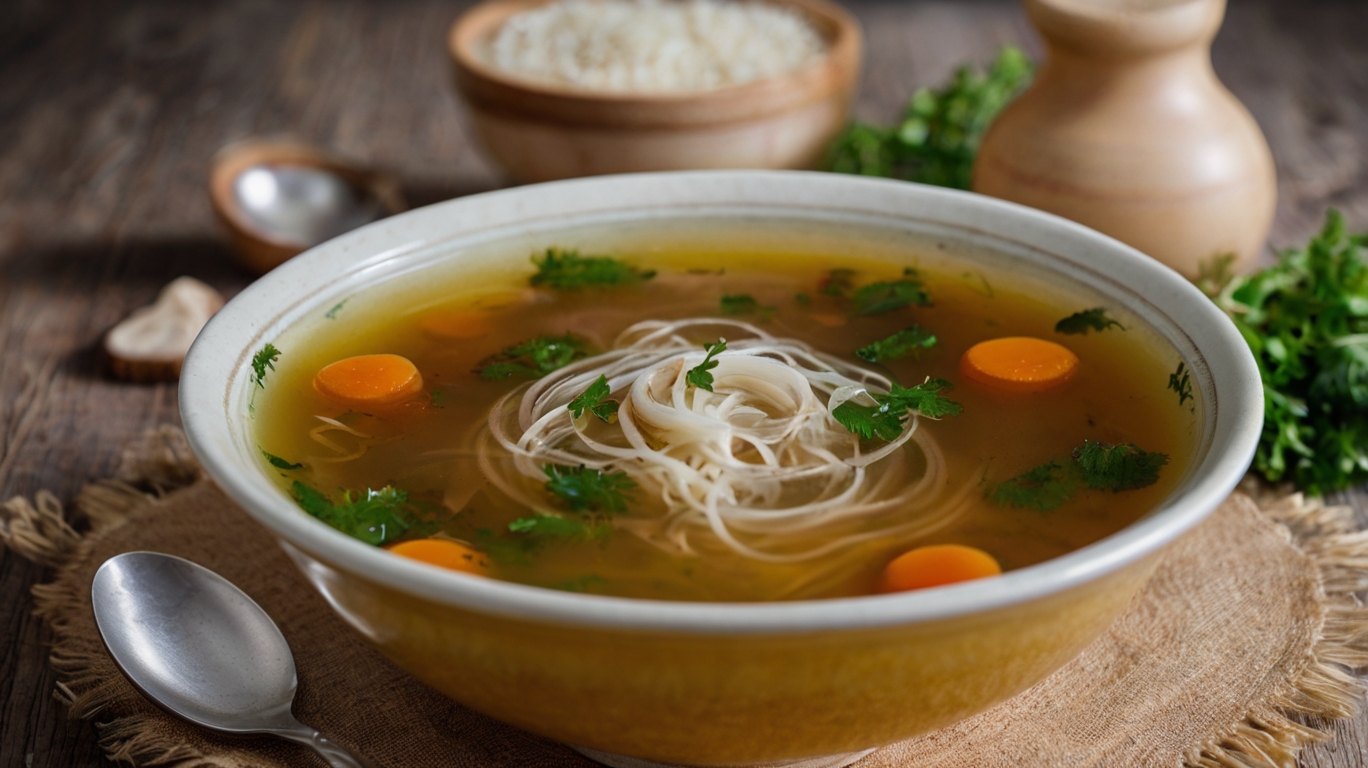How to Cook Clear Soup
How to Cook Clear Soup: The Ultimate Guide

by Arianne Nemna
Clear soup may look simple, but making it truly clear—glasslike in appearance and clean in flavor—is an art rooted in patience, technique, and ingredient choice. Whether you’re preparing a delicate consommé for a formal dinner or a clear vegetable broth to sip on a cold day, clarity is key. The process isn’t difficult, but it does require attention to the fundamentals: slow heat, clean skimming, and understanding what causes cloudiness in the first place.
This guide breaks down the principles behind a properly made clear soup, from stock selection and clarification methods to cooking times and serving suggestions. If you’re starting from scratch or refining your technique, every step here is meant to help you produce consistently clear, deeply flavored results every time.
- What Is Clear Soup? Understanding the Basics
- Choosing the Right Ingredients
- Essential Techniques for a Crystal-Clear Soup
- Classic Clear Soup Methods from Around the World
- Making Clear Soup in a Pressure Cooker or Instant Pot
- Troubleshooting Cloudy Soup & Quick Fixes
- Seasoning, Serving, and Garnishing for Clarity and Taste
- Storage, Reheating & Leftover Use
- 15+ FAQs on Cooking Clear Soup
What Is Clear Soup? Understanding the Basics
Clear Soup vs. Broth vs. Consommé
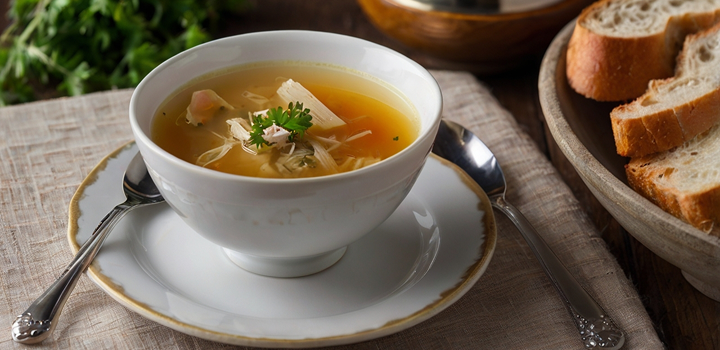
Defining Clarity in Culinary Terms
Clarity in soup refers to visual transparency and the absence of suspended particles, fat droplets, or cloudiness. A clear soup allows light to pass through cleanly, making it appear bright and almost jewel-like in a bowl. In culinary language, it’s more than just looks—it’s about precision. A consommé is the gold standard for clarity, created through a deliberate clarification process using egg whites to trap impurities. Broths, by contrast, are flavorful but typically not clarified, and they may contain floating solids or oils unless carefully strained.
Which Dishes Use Each Type
Clear soup is foundational in many cuisines. A consommé might start a French tasting menu, served with brunoise vegetables or herbs. A light chicken soup, strained carefully, forms the base of matzo ball soup or a Japanese osuimono. Broths, while related, are often used in cooking rather than sipping—think risottos, stews, or sauces. Each has its role, but clarity distinguishes the refined from the rustic.
Why Clarity Matters (Appearance, Texture, Experience)
Visual Appeal and Fine Dining Standards
In both home and professional kitchens, the appearance of a dish sets expectations. A clear soup signals cleanliness, refinement, and control in preparation. It’s the kind of dish that draws attention before a single spoonful reaches the mouth. In fine dining, this visual quality elevates the experience and showcases culinary skill.
How Texture Changes Perception of Flavor
A clear soup doesn’t just look smooth—it tastes smooth. Without fat floating on the surface or particles lingering on the tongue, the flavors come through more directly. This purity allows delicate aromatics like thyme, ginger, or citrus to shine without interference, making the overall experience cleaner and more satisfying.
Choosing the Right Ingredients
Using Bones, Vegetables, or Both
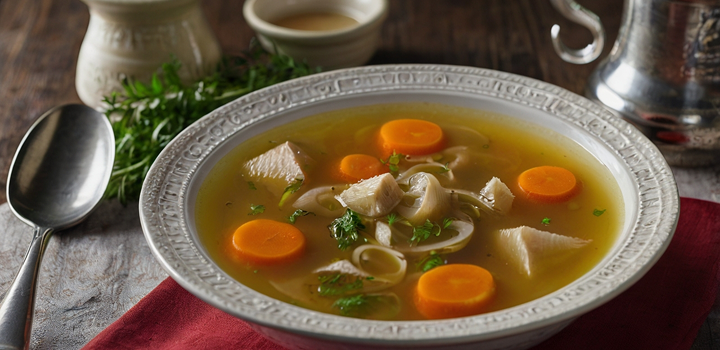
Chicken vs. Beef Bones — Which Are Better for Clarity
Both can work, but the choice affects not just flavor but visual result. Chicken bones, particularly wings and necks, yield a lighter-colored broth and set the stage for delicate clear soups. Beef bones produce a richer taste but must be used with care—marrow can add depth but also cloud the liquid if not blanched and skimmed properly. Always start by blanching bones to remove surface impurities before simmering.
Vegetable Bases That Don’t Cloud the Soup
Not all vegetables behave the same in water. Carrots, onions, leeks, and celery contribute flavor without breaking down excessively, making them ideal for clarity. Potatoes and starchy roots, on the other hand, can release particles that thicken and cloud the broth. Always wash vegetables thoroughly and cut them in large chunks to minimize particulate breakdown during cooking.
Cut Types & Quality Check (Lean vs. Fatty Cuts)
Why Fatty Cuts Can Cloud the Broth
Meats with a high fat content will render grease into the cooking liquid, which rises to the top in droplets or emulsifies into the broth if stirred. This is a primary cause of murkiness. For clear soups, use lean cuts or trim away excess fat before simmering. Clarification will remove suspended particles, but fat must be controlled early on.
Choosing Collagen-Rich Parts for Depth
Necks, wings, and knuckles contain connective tissue that breaks down into gelatin, giving the finished soup body without affecting clarity. These parts don’t release as much fat as richer cuts like thighs or chuck, and they help the broth feel satisfying in the mouth even while visually clear.
Essential Techniques for a Crystal-Clear Soup
Skimming Scum and Regulating Simmering
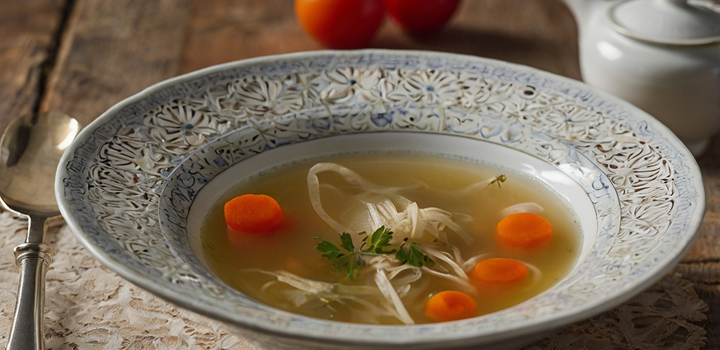
Best Skimming Tools and Timing
The moment bones or vegetables are submerged in hot water, proteins and impurities begin to rise to the surface. These form a grayish foam or “scum,” which must be removed as soon as it appears. The most effective time to skim is during the initial 30–45 minutes of cooking. A fine mesh skimmer or shallow ladle lets you glide just beneath the surface, lifting away the foam without disturbing the broth. Avoid stirring, as this can reincorporate solids back into the liquid.
Why Boiling Ruins Clarity
Once the soup reaches a full boil, rolling bubbles violently agitate the liquid. This distributes particles throughout the broth and causes fat to emulsify, making it nearly impossible to regain transparency. A proper clear soup should never boil—just simmer. You’re looking for a gentle heat where the surface quivers and a few bubbles rise slowly, preserving the calm needed for the solids to stay settled and flavors to extract cleanly.
Clarification via Egg-White Raft or Gelatin Filtration
Step-by-Step Egg Raft Method
This classical French technique is the standard for making consommé. First, the broth must be fully strained and chilled. Then, raw egg whites, finely chopped mirepoix (typically carrot, celery, and onion), and acidic ingredients like tomato are mixed together and stirred into the cold broth. As the mixture heats slowly, the egg whites coagulate and rise, forming a “raft” that traps impurities. Once the raft solidifies and floats, it’s gently pierced to allow the liquid to bubble through, becoming clearer as it circulates. After 45–60 minutes of simmering without stirring, the broth underneath should be crystal-clear and can be carefully ladled out or strained through cheesecloth.
Modern Gelatin Clarification for Cold-Set Broths
For chefs seeking innovation or working with cold broths, gelatin filtration offers a high-tech solution. Start with a strained broth, bloom gelatin in it, and allow the mixture to chill until fully set. Then, freeze the gelatin block solid. Once frozen, place the block in a mesh-lined strainer set over a bowl in the refrigerator. As it thaws slowly, clean broth drips through while the gelatin traps particles. This method doesn’t require heat and preserves delicate flavors, making it ideal for contemporary presentations and clear jellied aspics.
Classic Clear Soup Methods from Around the World
Asian-Style Clear Soups (e.g., Japanese, Chinese)
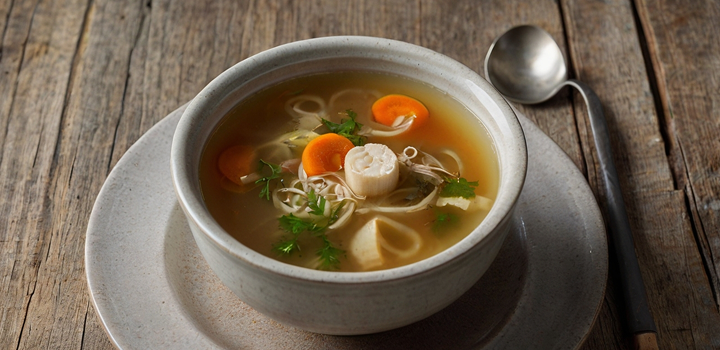
Japanese Osuimono and Kombu-Based Broths
Osuimono, a Japanese clear soup, is revered for its minimalism. The foundation is dashi, a stock made from kombu (dried kelp) and katsuobushi (bonito flakes), steeped gently to avoid clouding. The clarity of osuimono is so important that even the placement of garnishes—like mitsuba leaves or mushrooms—is done with care to maintain visual harmony. Because dashi extracts umami without simmering bones, it stays naturally clear and light.
Chinese Chicken Broth with Ginger and Scallion
Chinese clear soups often use whole chicken or chicken bones simmered with slices of ginger, scallion tops, and sometimes dried goji berries or jujubes. A key technique is the pre-blanching step: chicken is boiled briefly in clean water, rinsed, and then simmered in a fresh pot. This prevents blood and impurities from spoiling the clarity. The resulting broth is soothing and gently aromatic, often served as a prelude to more intense dishes.
Western Consommé Techniques
Mirepoix and Aromatics for French Consommé
French consommé elevates clear soup to a high art. Aromatics are used not only for flavor but also as part of the clarification raft. Mirepoix—onions, celery, and carrots—are chopped extremely fine so that their surface area contributes maximum flavor during clarification. Adding herbs like thyme and bay leaf is common, but they’re always wrapped or tied so particles don’t enter the broth.
When to Add Tomato or Acid to Aid Clarification
Acidic elements such as tomato paste or lemon juice help proteins coagulate more efficiently, which improves the strength of the raft and enhances flavor brightness. Timing is essential. If added too early, acid can dull clarity or over-coagulate; if added too late, it may not contribute enough. Ideally, acidity is introduced with the raft ingredients before the clarification begins, ensuring an even distribution throughout the broth.
Making Clear Soup in a Pressure Cooker or Instant Pot
Adjusting Time and Pressure for Maximum Clarity
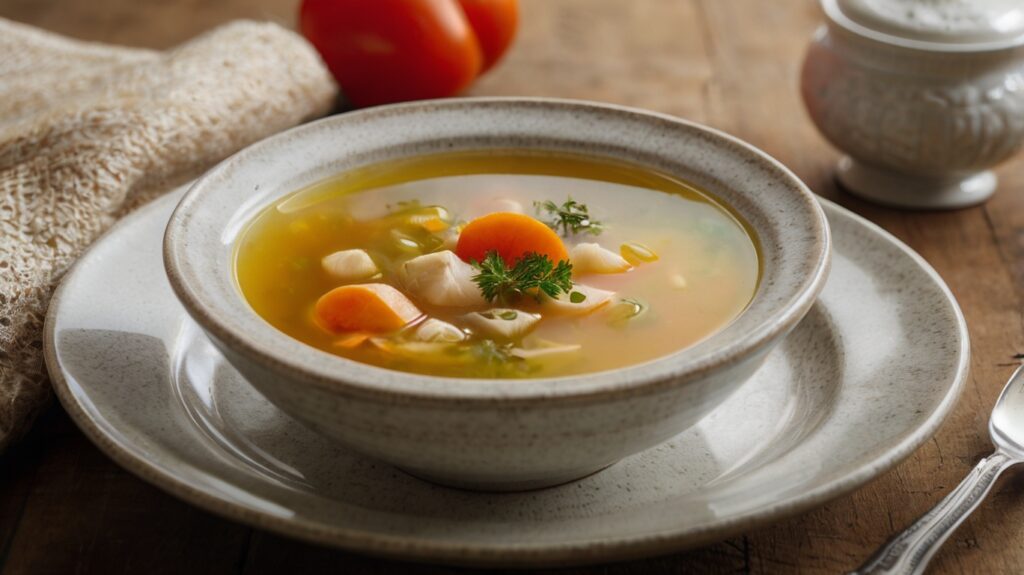
Pressure cookers offer speed and extraction efficiency but present challenges when clarity is a priority. To get a clear result, begin with a pre-blanched set of bones and carefully cleaned vegetables. Cook on low pressure when available, or high pressure for shorter durations. Ideal timing ranges from 25 to 35 minutes for poultry bones and 35 to 45 minutes for beef or pork. The reduced oxygen and high heat increase extraction, but also require stricter control of other clarity factors.
Natural Release vs. Quick Release
The pressure release method greatly affects the soup’s final texture and appearance. Natural release allows proteins and fat to settle without violent bubbling, minimizing turbulence and helping maintain clarity. Quick release may disturb the broth and stir up sediments, creating a cloudy result. For clear soup, always choose natural pressure release, even if it takes an extra 10–15 minutes.
Skimming in a Closed Cooking Environment
Unlike stovetop methods, skimming during pressure cooking isn’t possible mid-process. To compensate, it’s essential to skim aggressively before sealing the cooker. As soon as cooking ends and pressure releases, open the lid carefully and skim the surface before any stirring. Fat and impurities rise rapidly in hot broth under pressure, so this post-cook skim is vital.
Best Ingredients for Pressure-Cooked Broth
Avoiding Clouding with Onion Skins and Herbs
Pressure cookers intensify every ingredient’s effect. Ingredients that usually cause mild clouding—like onion skins, powdery herbs, or fatty meat scraps—become major culprits here. Always peel onions fully, avoid loose thyme or rosemary needles, and strain the broth through cheesecloth after cooking. Using only large, intact herbs (tied in bundles) reduces the risk of tiny particles dispersing under pressure.
Troubleshooting Cloudy Soup & Quick Fixes
What Causes Cloudy Soup

Boiling vs. Simmering Mistakes
When soup reaches a boil, proteins and fats emulsify and disperse through the liquid. This is especially problematic if the soup is stirred during or shortly after boiling. In clear soup, emulsified fat is almost impossible to remove completely. Even in a pressure cooker, cooking at high pressure too long can mimic this effect if the release is too aggressive.
Improper Skimming or Stirring
If impurities and fats aren’t removed early, or if the pot is stirred mid-cook, particles become suspended and contribute to murkiness. Stirring after cooking, especially when the broth is still hot, can also reintegrate sediment from the bottom. Proper ladling and leaving the bottom half-inch undisturbed during transfer help preserve clarity.
Rescue Methods for Murky Soup
When your broth turns out cloudy despite best efforts, not all is lost. These techniques can restore brightness.
Quick Straining Techniques
Start by passing the broth through a fine mesh sieve lined with damp cheesecloth. For additional clarity, repeat the straining step twice. If cheesecloth is unavailable, use a coffee filter set in a fine sieve. The key is patience—avoid pouring too quickly, which can disturb the sediment.
Re-clarifying with Egg White
If basic straining isn’t enough, re-clarification via egg white is a reliable solution. Whisk together one egg white per quart of cooled broth, optionally with chopped mirepoix and a spoon of crushed tomato. Stir into the broth while cold, then slowly bring to a low simmer. As the whites coagulate, they will form a raft, trapping particles. Once solidified, gently strain out the raft. This traditional consommé technique can rescue even severely clouded broths.
Infographic: Causes and Solutions for Cloudy Soup
| Problem | Cause | Best Fix |
| Cloudy after pressure cooking | Quick release disturbed sediment | Use natural release; strain gently |
| Greasy with floating bits | Inadequate skimming before cooking | Chill and remove fat cap; strain again |
| Gray and opaque | High heat boil or vigorous stirring | Re-clarify with egg whites |
| Slightly cloudy, mild flavor | Low-quality bones or poor vegetable prep | Use roasted or blanched bones; trim veggies |
| Cloudy from reheating | Stirring or boiling during reheat | Gently warm without stirring or boiling |
Seasoning, Serving, and Garnishing for Clarity and Taste
When to Add Salt, Herbs, or Acid
When making a clear soup, the timing of salt and acid additions not only affects flavor but also impacts clarity. Adding salt before boiling helps extract flavor from bones and vegetables, but too much can cause foaming. Many chefs prefer to salt the soup after straining to avoid altering the texture or taste.
Aromatic herbs like thyme, bay leaf, or parsley should be added whole—bundled or placed in a sachet—so they can be easily removed without leaving particles behind. Acidic ingredients such as lemon juice, wine, or vinegar are best added at the end, as too much acidity early on can break down proteins responsible for a clear broth.
Pre-Boil vs. Post-Clarification Timing
Before boiling: Salt can be used to maximize flavor extraction but risks cloudiness.
After straining: Ensures better clarity control and precise seasoning adjustment.
Before or after clarification: Acids should ideally be added at the very end to avoid denaturing coagulated proteins in the raft.
Vinegar, Wine, and Lemon – Enhancers or Hazards
When adding acidic ingredients, timing is critical. If introduced too early, the broth can turn grayish and cloudy due to uneven protein coagulation. It’s best to add acid after straining, just before serving. In white consommé, a small amount of dry white wine (1–2 tablespoons per liter) is acceptable.
Garnishes That Preserve Clarity
Brunoise Vegetables and Leafy Herbs
Finely diced vegetables (brunoise) add color and texture without compromising clarity. They should be blanched in salted water, cooled, and added just before serving. Leafy herbs like cilantro or dill should be stemmed and thoroughly dried to prevent introducing excess moisture or particles into the broth.
Clear Noodle Options and Their Impact
For Asian-style clear soups, glass noodles made from mung beans or sweet potato starch are excellent choices. They remain transparent when cooked and do not release starch into the broth. Always cook noodles separately, rinse in cold water, and add them to the bowl just before serving to preserve texture and clarity.
Storage, Reheating & Leftover Use
Cooling, Storing, Freezing Without Losing Clarity
Clear soup requires gentle handling during storage. Rapid cooling is crucial—pour the soup into shallow containers and cool over an ice bath or in cold water. Only then should it be transferred to the refrigerator or freezer.
Preventing Gel Breakdown When Reheating
Many broths, especially bone-based ones, form a gel when chilled. Upon reheating, avoid boiling, which breaks the gel structure and clouds the soup. Warm it gently to about 80–85°C (175–185°F), just enough to melt the gel without bubbling.
How Long to Keep It Before Clouding Starts
In the fridge at 2–4°C (35–39°F), clear soup stays pristine for up to 4–5 days. In the freezer, it lasts up to 3 months. However, repeated thawing and reheating accelerate structural loss. It’s best to store in single portions and thaw only once.
Table: Storage Methods and Maximum Shelf Life for Clear Soup
| Storage Method | Temperature | Maximum Duration | Special Notes |
| Refrigerator | 2–4 °C | 4–5 days | Store without vegetables or noodles |
| Freezer | –18 °C or lower | Up to 3 months | Freeze without herbs or added salt |
| Reheating | Up to 85 °C | Once only | Do not bring to a boil |
Repurposing Clear Soup
Risottos, Steamed Dishes, and Aspics
When you’re no longer serving the soup in its original form, it becomes a versatile base for other dishes. Use it in risotto instead of regular stock for a more refined flavor. In steaming (like dumplings or fish), even a small amount adds depth. A chilled, gelatin-rich broth can be turned into aspic or savory cold appetizers when combined with vinegar and set in molds.
Flavor Layering in Multi-Day Meal Prep
Clear broth is ideal for layered meal prep. First, it serves as soup. Next, it can become the base for sauces or grains. Later, it works as a cooking liquid for vegetables or porridge. With each use, reheat it gently and strain if needed to maintain purity.
15+ FAQs on Cooking Clear Soup
1. What is the difference between broth and clear soup?
Broth is a base liquid made from simmered bones, meat, and vegetables, and it’s not always perfectly clear. Clear soup is a type of broth that’s been clarified or cooked carefully to ensure maximum visual clarity. Clear soups are filtered and degreased, often served without any cloudy elements, making them suitable for elegant presentations or dietary uses.
2. How do I keep my soup from getting cloudy?
Avoid boiling the liquid—boiling emulsifies fat and impurities into the broth. Instead, keep it at a low simmer and skim frequently. Stirring too often, not rinsing bones, or letting fat re-enter the broth after skimming are also common causes of cloudiness.
3. Do I need to use egg whites to clarify soup?
Not always. Egg-white clarification (raft method) is common for consommé, but if you start with clean bones, gently simmer, and skim regularly, you can still get a very clear result. The egg method is best when visual perfection is required.
4. Can I make clear soup in a pressure cooker?
Yes, but it requires post-cooking filtration. Use high-quality ingredients, avoid onion skins, and always strain the broth through fine mesh or a double layer of cheesecloth. Since skimming isn’t possible inside a sealed cooker, let the pressure release naturally to avoid disturbance.
5. Why is my clear soup gelatinous when cold?
That’s a good sign. It means your broth contains collagen, which gels naturally upon chilling. This contributes to body and mouthfeel. Upon reheating, it will liquefy again, as long as you don’t overboil.
6. Can I freeze clear soup without ruining its clarity?
Yes, but you should strain it thoroughly before freezing. Store in airtight containers, label by date, and defrost gently in the refrigerator. Avoid multiple thaw-refreeze cycles, as they can create separation or graininess.
7. When should I salt the soup?
Ideally after straining, especially if clarity is your goal. Early salting can cause proteins to release and coagulate prematurely. Finishing the soup with salt lets you control the seasoning without compromising texture.
8. What vegetables are best for clear soup?
Use pale, low-starch vegetables like leeks, celery, and carrots. Avoid potatoes or strongly pigmented items like red cabbage or beets, which can alter the color and clarity of the broth.
9. Can I add pasta or rice to clear soup?
You can, but it’s better to cook them separately and add just before serving. Grains release starch during cooking, which clouds the broth. Choose thin noodles or pre-rinsed cooked rice to minimize impact on clarity.
10. Why did my soup taste bland even though it looks clear?
Over-skimming or under-seasoning can strip away flavor. Also, relying on too much water with not enough bones or aromatics can dilute taste. A well-balanced broth starts with high-quality, correctly portioned ingredients.
11. Can I use fish bones for clear soup?
Absolutely. Fish fumet (clear fish broth) is a classic base in French cuisine. Use white fish bones, avoid oily species, and cook for shorter periods—typically 20–30 minutes—to prevent bitterness or overpowering flavors.
12. How long can I keep clear soup in the fridge?
Properly cooled and stored, it stays good for up to 4–5 days. Keep it sealed tightly and chilled at or below 4 °C (40 °F). If you notice any sour smell or surface film, discard it.
13. Can I clarify cloudy soup after it’s already been cooked?
Yes, using the egg white raft method. Beat egg whites, mix with cold soup, then heat gently while whisking. The egg proteins will collect impurities as they coagulate. Strain carefully after simmering.
14. What kind of pot should I use for best clarity?
Use a tall, heavy-bottomed stainless steel or enameled stockpot. Avoid aluminum, as it can react with acids. A tall pot minimizes surface area, which helps reduce evaporation and splashing impurities back into the soup.
15. Can I flavor clear soup with herbs without losing clarity?
Yes, if used whole and removed before serving. Create an herb bundle tied with twine or use a tea infuser. This way, the flavors infuse without releasing particles or clouding the liquid.
